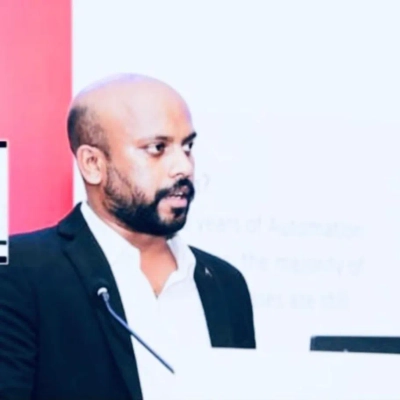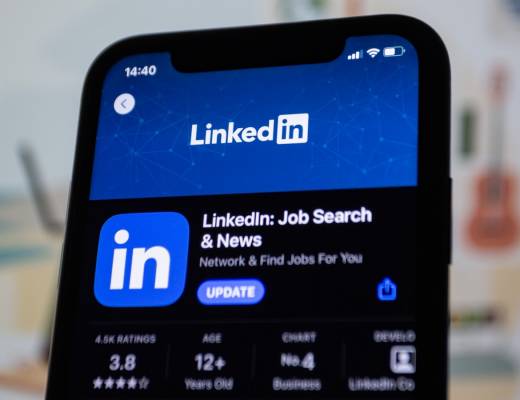Workplace innovation frequently starts with employees taking initiative to improve their environment. We asked industry experts to share an example of a time when they took the initiative to improve a process or solve a problem at work. Here is what motivated them to take action — and the results. Discover how these proactive approaches led to significant improvements in efficiency, client satisfaction, and overall company performance.
- Proactive QA Optimization Boosts Client Confidence
- Streamlining Workflows Elevates Agency Performance
- Centralized Feedback System Enhances Project Efficiency
- Revamped Lead Scoring Improves Sales Effectiveness
- User-Centric Redesign Boosts Assessment Completion Rates
- Consolidating Client Communication Reduces Confusion
- Internal SEO Guide Empowers Content Writers
- Unified Platform Enhances Team Coordination
- Automated Spending Decisions Save Time
- Implementing EOS Resolves Scaling Communication Issues
- Qualification Framework Transforms Sales Pipeline
- Test Triage Agent Accelerates Bug Resolution
- Custom Dashboard Revolutionizes Marketing Reports
- Tailored Software Streamlines Hotel Operations
- Client Insights Reshape Artist’s Approach
- Automated Reporting Saves Time
- Customized System Improves Guest Experience
- Uncovering Client Needs Transforms Artist’s Career
Proactive QA Optimization Boosts Client Confidence
One example comes from a long-term partnership with a financial services client who was facing ongoing delays in their development cycles due to fragmented testing processes. While the original scope of our engagement didn’t include QA optimization, our team noticed that inconsistent testing environments and manual regression testing were contributing to release slowdowns and post-launch bugs.
Motivated by a desire to improve delivery speed and reliability, we proposed and implemented a shift toward automated testing, integrating it with our CI/CD pipeline. We worked closely with both the client’s internal QA and DevOps teams to select the right tools, standardize environments, and set up automated test coverage for high-risk areas.
The result: the client saw a noticeable reduction in critical bugs and was able to release updates more frequently with greater confidence. This initiative not only strengthened the product but also deepened the client’s trust in our ability to improve their operations proactively.
 Sergiy Fitsak
Sergiy Fitsak
Managing Director, Fintech Expert, Softjourn
Streamlining Workflows Elevates Agency Performance
Early in my entrepreneurial journey, I noticed something that kept bottlenecking growth — not a lack of ideas or talent, but messy, bloated workflows. We were great at doing, but terrible at streamlining. Our campaigns were effective, but behind the scenes, it felt like duct tape held everything together. That friction wasn’t just annoying — it was expensive, draining time, energy, and momentum. So I decided to fix it.
Without waiting for a “perfect time,” I dove into a full audit of how we were operating. I mapped our content, campaign, and client onboarding systems and realized we were reinventing the wheel with every new project. Templates were outdated. The tools didn’t talk to each other. Important files lived in 15 different places. It was chaos disguised as hustle.
I redesigned everything, built modular templates for repeatable tasks, and connected our apps to automate steps that used to eat hours. I created a central hub where everything lived in one intuitive system. And the impact? Turnaround times dropped by over 30%. The team was less reactive and more strategic. We spent more time thinking and less time chasing.
Finding a Better Way
What motivated me was simple: I was tired of being the enemy of progress. I didn’t want to build something that just looked good on the outside. I wanted it to feel good from the inside, too. That shift — from clutter to clarity — didn’t just improve our efficiency, it elevated how we showed up for our clients and each other.
That experience taught me something important: You don’t need a big title to lead change. You just need to care enough to say, “There has to be a better way,” and then have the courage to build it.
In a world that glamorizes constant motion, real leverage often comes from stepping back, simplifying, and being brave enough to question what everyone else is tolerating. That mindset has stayed with me — and it’s shaped how we operate at Bamboost today: intentionally, creatively, and consistently with an eye toward sustainable growth.
 John Mac
John Mac
Serial Entrepreneur, UNIBATT
Centralized Feedback System Enhances Project Efficiency
One client had four stakeholders sending edits through different email threads. This process slowed us down, confused everyone, and led to contradicting requests. I proposed using one central Google Doc for final comments only. This approach streamlined reviews and made all edits trackable and accountable.
I acted because the back-and-forth had become frustrating for the entire team. With this change, we cut feedback time by at least 40 percent. The client even adopted our system for their internal workflows. It felt great knowing our solution helped beyond just our work.
 Jason Hennessey
Jason Hennessey
CEO, Hennessey Digital
Revamped Lead Scoring Improves Sales Effectiveness
There was a phase where our sales team would close a project, and then things would stall. The delivery team would come in confused, asking questions that should have already been answered. It wasn’t anyone’s fault; the process simply didn’t exist.
I didn’t create a complex system. I literally opened a document and wrote down five questions that sales should answer before handing anything off. These included questions like: What is the client actually expecting? What was promised? Are there any early red flags? I shared it in one meeting, and we agreed to try it for a few weeks.
It worked. The delivery team got the clarity they needed. Sales didn’t feel like they were repeating themselves. And kickoff meetings stopped being awkward.
I didn’t do this because I had spare time. I was just tired of watching smart people waste hours fixing avoidable confusion. That’s usually what motivates me, not strategy decks, but noticing when something’s broken and nobody’s fixing it.
 Vikrant Bhalodia
Vikrant Bhalodia
Head of Marketing & People Ops, WeblineIndia
User-Centric Redesign Boosts Assessment Completion Rates
We took the initiative to build a detailed, centralized SEO process in Notion to bring structure and consistency to our workflows. The fast-paced nature of SEO drove the decision — what works one quarter can quickly become outdated the next. Without a clearly documented and easily accessible system, it became clear that staying aligned and scaling best practices across the team would be difficult.
The Notion setup breaks down every aspect of our SEO delivery, covering audits, technical SEO, keyword research, content strategy, on-page optimization, and link building. Each section is mapped with specific steps, templates, and tools, and we regularly review and update the process based on new algorithm changes, tool updates, or proven methods we discover in day-to-day work.
This living system has improved our ability to train new team members, ensure consistency across accounts, and keep the entire agency operating with the most current, effective strategies. It’s helped reduce errors, speed up delivery, and allowed us to maintain a higher standard of SEO across the board.
 Luke Hickman
Luke Hickman
Chief Marketing Officer, Bird Digital Marketing Agency UK
Consolidating Client Communication Reduces Confusion
I noticed that our sales team was spending a lot of time chasing low-quality leads, which affected our overall efficiency. To address this, I took the initiative to revamp our lead scoring system to prioritize leads more effectively.
I worked with the team to define key criteria — such as engagement level, company size, and fit with our ideal customer profile — and implemented an automated system to score and rank leads accordingly. This way, the sales team could focus on high-value prospects that were most likely to convert.
The results were immediate. The team’s focus shifted to more qualified leads, increasing our conversion rate and overall sales efficiency. By prioritizing leads that aligned better with our business goals, we not only saved time but also built stronger relationships with the right prospects.
 Ameet Mehta
Ameet Mehta
Co-Founder, SponsorCloud.io
Internal SEO Guide Empowers Content Writers
One of the most impactful moments was when we overhauled our client feedback loop. We had been receiving vague, delayed feedback that was slowing down revisions and negatively affecting timelines.
I created a standardized feedback form with specific prompts tied to each stage of our content workflow. Then we introduced a 15-minute review call after every major delivery. It wasn’t revolutionary, but it was intentional. What motivated me? The team’s frustration. We were spending too much time guessing what clients wanted.
The result? Turnaround time improved by 30 percent, and client satisfaction scores increased. It showed me that even small process changes, when implemented thoughtfully, can drive huge efficiency gains and reduce stress for everyone.
 Vaibhav Kishnani
Vaibhav Kishnani
Founder & CEO, Content-Whale
Unified Platform Enhances Team Coordination
One of the early challenges we faced was a high drop-off rate during the candidate assessment flow. Recruiters would set up assessments, but candidates often didn’t complete them — hurting both user satisfaction and platform credibility.
I took the initiative to investigate by analyzing user behavior, reviewing candidate feedback, and shadowing our support team. What I found was simple but critical: the UX wasn’t mobile-friendly, and candidates didn’t understand the test’s duration.
Motivated by how this impacted our customers’ hiring outcomes, I worked closely with product and design teams to redesign the assessment intro screen, add time estimates, improve mobile responsiveness, and build a reminder email workflow.
Within a month of the updates, completion rates improved by 38%, and support tickets related to candidate confusion dropped significantly. It was a reminder that small changes — driven by user empathy — can create a major impact.
 Abhishek Shah
Abhishek Shah
Founder, Testlify
Automated Spending Decisions Save Time
One process that I noticed within the last year that really needed some tuning up was our process around client communication. I believe the issue here was that there were too many people involved, so client communication was being shared between multiple people, and clients were receiving conflicting or duplicate information and becoming confused.
Really, what motivated me the most was trying to streamline some business processes, along with repeated client feedback. Automating some communication for simple requests and otherwise streamlining the communication to one or two staff members for each inquiry has been very helpful.
 Soumya Mahapatra
Soumya Mahapatra
CEO, Essenvia
Implementing EOS Resolves Scaling Communication Issues
Our content writers kept asking similar SEO questions every single week. I built a searchable internal guide that covered our agency-specific standards. The guide included tone guidelines, on-page structure, and link protocols. It became a go-to resource that reduced Slack messages and improved output.
I initiated this project because I disliked repeating information and wasting mental bandwidth. It helped junior writers develop their skills more quickly and reduced editing rounds across the board. Writers reported that it gave them more confidence in their drafts. This small system saved hours every month with zero pushback.
 Marc Bishop
Marc Bishop
Director, Wytlabs
Qualification Framework Transforms Sales Pipeline
Our team was wasting precious time as communication was spread over various channels, leading to confusion and missed deadlines. I took the initiative to organize everyone and propose a single platform where all project updates and tasks would be located. I explained how this would minimize back-and-forth emails and make everything transparent. My motivation came from the fact that we kept making the same mistakes and experiencing delays that cost us time. Since we made the switch, the work process has become easier, deadlines can be monitored more effectively, and the general coordination of the team has improved. This slight modification has saved us hours per week and enabled us to deliver projects on time more frequently.
 Mark Tipton
Mark Tipton
CEO & Founder, Aspire
Test Triage Agent Accelerates Bug Resolution
For a long time after we launched, all of our spending decisions — from payroll to marketing to software to overhead — went directly through me. I had to individually sign off on everything because I was responsible for tracking our funding levels. Even though it’s not something I’m naturally talented at, I spent a few weeks learning to automate these processes, including setting up some basic escalators in an Excel spreadsheet, to save time and reduce tedium.
 Jonathan Palley
Jonathan Palley
CEO, QR Codes Unlimited
Custom Dashboard Revolutionizes Marketing Reports
When the company scaled from 4 to 50 employees, communication broke down completely.
People duplicated work, deadlines slipped, morale nosedived, and I spent my whole day attending several meetings to coordinate people. I realized I was becoming the bottleneck, and every decision flowed through me.
But I found a solution, and it wasn’t putting in more hours.
It was the Entrepreneurial Operating System (EOS), involving crisp roles, weekly scorecards, and decision-making frameworks.
The result? Amazing! The default mode of firefighting gave way to a more organized work process as teams solved issues independently, and launches stayed on track because of the clear decision-making framework. And the best part is that I got my afternoons back for strategic meetings instead of solving blockers all day.
So if you’ve become the bottleneck, stop muscling through and build a system that works without you.
 Alexander De Ridder
Alexander De Ridder
Co-Founder & CTO, SmythOS.com
Tailored Software Streamlines Hotel Operations
Our lead qualification process was creating massive inefficiencies because sales representatives were spending most of their time on unqualified prospects who lacked budget and decision-making authority. I noticed this pattern while reviewing weekly pipeline reports and realized we needed better filtering before leads reached the sales team.
I developed a multi-step qualification framework that combined behavioral scoring with direct qualification questions, then automated the initial screening through our CRM workflows. Instead of waiting for management approval, I tested the system with three sales representatives over two weeks, tracking their time allocation and conversion rates. The results were immediately apparent; qualified leads increased by 180% while time spent on dead-end prospects dropped by 65%. One representative went from closing two deals per month to 7 deals using the new system.
What motivated me was watching talented sales professionals get frustrated with low-quality leads that wasted their expertise on prospects who were never going to buy. After implementing the qualification system company-wide, our sales team’s close rate improved from 8% to 23% within three months. The process changes also improved team morale because representatives could focus on strategic selling rather than endless discovery calls with unqualified prospects. Taking initiative to solve this problem strengthened my relationship with the sales team and demonstrated the value of systematic process improvement over hoping for better lead quality.
 Brandon George
Brandon George
Director of Demand Generation & Content, Thrive Internet Marketing Agency
Client Insights Reshape Artist’s Approach
I believe that the best changes often start from small points of friction. One example that stands out is when we noticed that test failures in our CI pipeline were accumulating without clear triage. Engineers were spending hours rerunning tests without knowing if the issue was flaky code, environment noise, or a real regression.
I took the initiative to prototype a test triage agent that incorporated past test outcomes, recent code changes, and flakiness history. Instead of reacting blindly, the system assigned a likelihood score and suggested next steps such as rerun, investigate, or ignore.
What motivated me was seeing senior engineers lose valuable time on something that could have been resolved with better context. Within two weeks, false positive investigations decreased by 40 percent, and resolution speed improved significantly.
It was not just about automation. It was about creating space for people to focus on what actually moves the product forward.
 Vivek Nair
Vivek Nair
Co-Founder, BotGauge
Automated Reporting Saves Time
I love fixing what slows people down. At my company, where I was the co-founder and digital marketing strategist, I noticed something that irked me: we were squandering a terrible amount of time creating marketing reports. We were transferring numbers back and forth from here and there, drawing hand charts, and it was a significant amount of time wasted.
I might have let that slide, but I decided to develop a more simplified alternative. I came up with a custom dashboard (basically a smart report) that pulled all of our marketing data into one place, automatically. It showed us at a glance just how ads, emails, and content were performing, all in one.
I’ve had a marketing career spanning almost 20 years, with experience working in China, the United Kingdom, and North America. I’ve learned that time is highly valuable, especially for someone who’s working on fast-moving brands. I’m an expert at digital strategy, PR, and content marketing, and I recognized the need for improvement. Also, I wanted to allow the team to focus on smart ideas rather than manually transferring numbers.
Once we implemented the solution, we were saving heaps of time, a whole 70%! We could now make quicker decisions, provide better updates to customers, and reduce stress for staff. Everyone was happier as a result. That’s the kind of problem-solving I love: simple, savvy, and productive.
Marketing is not just advertising. Marketing is about making things work better, so people can think big, move fast, and grow their brand. That’s what I’m doing regularly.
 Linda Yang
Linda Yang
Co-Founder, Digital Marketing Strategist, PR & Content Marketing, Toteprint.com
Customized System Improves Guest Experience
One example that stands out is from my time running Design Suites, where we managed over 500 condo-hotel units in Miami. At one point, our check-in and cleaning process was in disarray. Guests were arriving to rooms that were not ready, housekeeping staff were unclear on priorities, and front desk agents were overwhelmed. This situation created stress, delays, and negative reviews.
I decided to take the initiative and address the issue. Our property management system already had a housekeeping module, but it was built on logic that did not align with our operational methods. Instead of forcing our team to adapt to it, I collaborated with our developer to customize the software to match our internal workflow. We developed a real-time coordination system that connected reservations, cleaning status, and staff assignments with a simple, visual interface.
Customizing Helps Workflow
The customizations did more than improve visibility. They helped guide the team to follow a consistent process. Housekeepers knew exactly which units to prioritize. Front desk staff could see in real time which rooms were ready and which were delayed. This eliminated guesswork and stopped the blame game.
What motivated me was the frustration of seeing capable people fail because of an inefficient system. I knew that if we could structure the process around our actual workflow, we could achieve better results with the same team. And it worked. Wait times were reduced by half. Reviews improved. Staff experienced less friction and had more clarity. And guests received what they expected — a smooth, professional experience.
That experience taught me a lesson I still apply to everything I do today, including my work as an artist. Problems do not resolve themselves. You have to take ownership, identify the weak spots, and build something that actually works. When you do, everyone benefits — the team, the client, and the brand.
 Facundo Yebne
Facundo Yebne
Creative Mind, FLY Miami Art
Uncovering Client Needs Transforms Artist’s Career
When my career first started gaining traction and I landed those key early gigs — think dream clients — the initial excitement quickly gave way to confusion. I realized I had no idea how they found me or why they chose to hire me. How could I repeat something I didn’t understand?
So I took the initiative to dig in and ask uncomfortable questions. To my surprise, I was solving a different problem (JTBD) than I had assumed. That lesson shifted everything — my pitch, my production, my entire approach. I began reflecting a viewpoint to the cities I worked with that made sense to them. It became the foundation of a lifelong international career.
 Kurt Perschke
Kurt Perschke
Artist, RedBall Project







